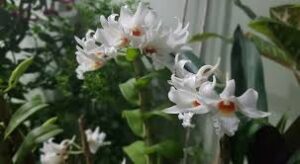# Caring for and Cultivating Dendrobium Orchids in Greenhouses

Dendrobium orchids are celebrated for their vibrant blooms, diverse species, and ease of cultivation, making them a popular choice for both amateur and professional horticulturists. When grown in a greenhouse, these orchids can thrive, benefiting from a controlled environment that optimizes their growth conditions. This comprehensive guide will explore the best practices for caring for and cultivating Dendrobium orchids in greenhouses, covering everything from environmental conditions to watering, fertilization, pest management, and propagation.
## Table of Contents
1. **Introduction to Dendrobium Orchids**
– 1.1 Overview of Dendrobium Species
– 1.2 Benefits of Growing Dendrobiums in Greenhouses
2. **Setting Up the Greenhouse Environment**
– 2.1 Choosing the Right Greenhouse
– 2.2 Environmental Control Systems
– 2.3 Light Requirements
– 2.4 Temperature Control
– 2.5 Humidity Levels
3. **Selecting the Right Growing Medium**
– 3.1 Potting Mixes for Dendrobium Orchids
– 3.2 Container Choices
4. **Watering Techniques**
– 4.1 Understanding Water Needs
– 4.2 Watering Methods
– 4.3 Signs of Overwatering and Underwatering
5. **Fertilization and Nutrient Management**
– 5.1 Nutritional Requirements
– 5.2 Types of Fertilizers
– 5.3 Application Techniques
6. **Pest and Disease Management**
– 6.1 Common Pests and Diseases
– 6.2 Prevention Strategies
– 6.3 Treatment Options
7. **Propagation Techniques**
– 7.1 Division
– 7.2 Cuttings
– 7.3 Tissue Culture
8. **Seasonal Care and Maintenance**
– 8.1 Spring and Summer Care
– 8.2 Fall and Winter Care
9. **Conclusion**
– 9.1 Summary of Key Points
– 9.2 Final Thoughts on Dendrobium Orchid Cultivation
—
## 1. Introduction to Dendrobium Orchids
### 1.1 Overview of Dendrobium Species
Dendrobium orchids belong to one of the largest genera of orchids, with over 1,800 species and countless hybrids. They are known for their remarkable adaptability and stunning flowers, which can range in color from deep purples and pinks to soft whites and yellows. Popular species include:
– **Dendrobium nobile**: Characterized by its upright stems and fragrant blooms, this species is commonly cultivated for its attractive flowers.
– **Dendrobium phalaenopsis**: Resembling moths, this species is favored for its long-lasting and showy flowers.
– **Dendrobium bigibbum**: Also known as the Cooktown orchid, this variety features vibrant, eye-catching flowers.
Understanding the unique characteristics of different Dendrobium species is essential for providing the right care and ensuring optimal growth.
### 1.2 Benefits of Growing Dendrobiums in Greenhouses
Growing Dendrobium orchids in greenhouses offers numerous advantages:
– **Controlled Environment**: Greenhouses allow for precise control over temperature, humidity, and light levels, creating an ideal environment for orchid growth.
– **Protection from Pests and Diseases**: Greenhouses provide a barrier against pests and diseases, reducing the risk of infestations and infections.
– **Extended Growing Seasons**: With controlled conditions, orchids can thrive year-round, allowing for multiple blooming cycles.
## 2. Setting Up the Greenhouse Environment
### 2.1 Choosing the Right Greenhouse
When selecting a greenhouse for growing Dendrobium orchids, consider the following factors:
– **Size**: Choose a greenhouse that provides ample space for your orchids to grow without overcrowding.
– **Materials**: Look for sturdy materials that offer good insulation, such as polycarbonate or glass. These materials help regulate temperature and humidity levels.
– **Ventilation**: Ensure that the greenhouse has adequate ventilation to allow for air circulation and temperature control.
### 2.2 Environmental Control Systems
Implementing environmental control systems is crucial for maintaining optimal conditions in your greenhouse:
– **Heating Systems**: In colder climates, install heating systems to maintain a stable temperature during winter months.
– **Cooling Systems**: Use exhaust fans or shade cloths to lower temperatures during hot weather.
– **Humidity Control**: Consider using humidifiers or misting systems to maintain appropriate humidity levels.
### 2.3 Light Requirements
Dendrobium orchids thrive in bright, indirect sunlight. In the greenhouse:
– **Natural Light**: Position your orchids where they can receive ample natural light without direct sun exposure, which can scorch the leaves.
– **Supplemental Lighting**: If natural light is insufficient, use grow lights to provide additional light during shorter days.
### 2.4 Temperature Control
Maintaining the right temperature is vital for Dendrobium orchids:
– **Daytime Temperatures**: Aim for temperatures between 70°F and 85°F (21°C to 29°C) during the day.
– **Nighttime Temperatures**: At night, temperatures should ideally drop to between 60°F and 70°F (15°C to 21°C).
### 2.5 Humidity Levels
Dendrobium orchids thrive in humidity levels of 50% to 70%. To maintain these levels:
– **Humidity Monitors**: Use hygrometers to monitor humidity levels in your greenhouse.
– **Misting**: Mist your orchids regularly, especially during dry spells, to increase humidity.
## 3. Selecting the Right Growing Medium
### 3.1 Potting Mixes for Dendrobium Orchids
Choosing the right potting mix is essential for the health of your Dendrobium orchids. A well-draining mix allows for proper aeration while retaining moisture. Consider the following components:
– **Bark Chips**: Fir or pine bark chips are commonly used in orchid mixes to provide excellent drainage and aeration.
– **Sphagnum Moss**: This helps retain moisture and provides additional aeration when mixed with bark.
– **Perlite**: Adding perlite can enhance drainage and prevent compaction.
### 3.2 Container Choices
The choice of container can impact the growth of Dendrobium orchids:
– **Plastic Pots**: Lightweight and retain moisture well, plastic pots are a popular choice for orchids.
– **Clay Pots**: These allow for better aeration but can dry out quickly, requiring more frequent watering.
## 4. Watering Techniques
### 4.1 Understanding Water Needs
Dendrobium orchids have specific watering needs that vary based on their growth stage and environmental conditions:
– **Growing Season**: During active growth, orchids will require more frequent watering as they absorb moisture for new growth and flowering.
– **Dormant Season**: In the fall and winter, reduce watering as the plants enter dormancy.
### 4.2 Watering Methods
Different watering methods can be employed to meet the needs of your Dendrobium orchids:
– **Soaking Method**: Submerge the pot in water for about 15-30 minutes, allowing the roots to absorb moisture before draining excess water.
– **Top Watering**: Water the orchids from above, ensuring that water seeps through the drainage holes. Avoid letting water sit in the saucer beneath the pot.
### 4.3 Signs of Overwatering and Underwatering
Monitoring your orchids for signs of water stress is essential:
– **Overwatering**: Yellowing leaves, mushy roots, and a foul odor from the potting medium are indicators of overwatering.
– **Underwatering**: Wrinkled or shriveled pseudobulbs and leaves are signs that the orchid needs more water.
## 5. Fertilization and Nutrient Management
### 5.1 Nutritional Requirements
Dendrobium orchids require a balanced supply of nutrients for healthy growth and flowering:
– **Nitrogen**: Essential for leaf growth and overall vigor.
– **Phosphorus**: Important for root development and flowering.
– **Potassium**: Aids in overall plant health and disease resistance.
### 5.2 Types of Fertilizers
Choose from various types of fertilizers suitable for orchids:
– **Balanced Fertilizers**: Use fertilizers with equal N-P-K ratios (e.g., 20-20-20) during the growing season.
– **Orchid-Specific Fertilizers**: Formulated specifically for orchids, these fertilizers often contain slow-release nutrients.
### 5.3 Application Techniques
When applying fertilizer, consider the following techniques:
– **Dilution**: Always dilute fertilizers according to package instructions to avoid root burn.
– **Frequency**: Fertilize every two to four weeks during the growing season and reduce frequency during dormancy.
## 6. Pest and Disease Management
### 6.1 Common Pests and Diseases
Dendrobium orchids can be susceptible to various pests and diseases:
– **Aphids**: These pests suck the sap from the plant, leading to stunted growth.
– **Mealybugs**: Known for their cotton-like appearance, they can weaken the plant and cause leaf drop.
– **Fungal Infections**: Root rot, caused by overwatering or poor drainage, is a common issue.
### 6.2 Prevention Strategies
Preventing pests and diseases is key to maintaining healthy orchids:
– **Regular Inspections**: Routinely check your orchids for signs of pests or diseases and take action promptly.
– **Clean Environment**: Keep the greenhouse clean and
free of debris, which can harbor pests.
### 6.3 Treatment Options
If pests or diseases are detected, consider these treatment options:
– **Insecticidal Soap**: Effective against soft-bodied pests like aphids and mealybugs.
– **Fungicides**: Use fungicides as a preventive measure or to treat fungal infections.
## 7. Propagation Techniques
### 7.1 Division
One of the most common methods of propagating Dendrobium orchids is division:
– **Timing**: Divide your orchids in the spring when they are actively growing.
– **Technique**: Carefully remove the plant from its pot and separate the rhizomes, ensuring each division has healthy roots and growth nodes.
### 7.2 Cuttings
Another propagation method is taking cuttings:
– **Selection**: Choose healthy stems with at least two nodes.
– **Preparation**: Cut the stem below a node and allow it to callous over before planting in a suitable medium.
### 7.3 Tissue Culture
Tissue culture is a more advanced propagation method that allows for mass production of orchids:
– **Sterile Environment**: Perform tissue culture in a sterile lab setting to prevent contamination.
– **Growth Media**: Use specialized growth media to support the development of new plants from tissue samples.
## 8. Seasonal Care and Maintenance
### 8.1 Spring and Summer Care
During the growing season, focus on promoting healthy growth:
– **Increase Watering**: As the temperatures rise, increase watering frequency to meet the plant’s needs.
– **Fertilization**: Apply balanced fertilizers every two to four weeks to support growth and blooming.
### 8.2 Fall and Winter Care
As the seasons change, adjust your care practices:
– **Reduce Watering**: Cut back on watering as the plants enter dormancy, allowing the medium to dry out slightly between waterings.
– **Temperature Management**: Ensure that temperatures remain within the ideal range to prevent cold damage.
## 9. Conclusion
### 9.1 Summary of Key Points
Caring for and cultivating Dendrobium orchids in greenhouses requires attention to environmental conditions, proper watering and fertilization, pest management, and propagation techniques. By providing the right care, you can enjoy beautiful blooms year-round.
### 9.2 Final Thoughts on Dendrobium Orchid Cultivation
Dendrobium orchids are rewarding plants to grow, and with the right knowledge and techniques, they can thrive in a greenhouse environment. Whether you’re a novice or an experienced grower, following this guide will help you cultivate these stunning orchids successfully, bringing beauty and elegance to your home or garden. Happy growing!


